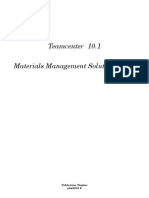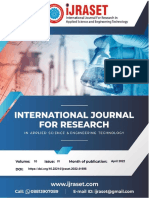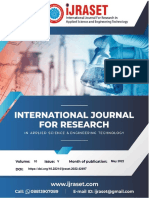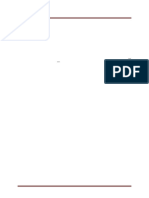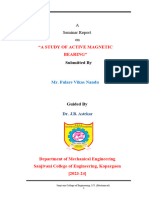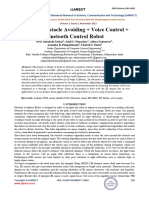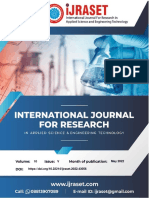IRJMETS40300087641
IRJMETS40300087641
Uploaded by
38 aarti dhageCopyright:
Available Formats
IRJMETS40300087641
IRJMETS40300087641
Uploaded by
38 aarti dhageCopyright
Available Formats
Share this document
Did you find this document useful?
Is this content inappropriate?
Copyright:
Available Formats
IRJMETS40300087641
IRJMETS40300087641
Uploaded by
38 aarti dhageCopyright:
Available Formats
e-ISSN: 2582-5208
International Research Journal of Modernization in Engineering Technology and Science
( Peer-Reviewed, Open Access, Fully Refereed International Journal )
Volume:04/Issue:03/March-2022 Impact Factor- 6.752 www.irjmets.com
A ADVANCE STICK FOR VISUALLY PEOPLE BASED ON IOT
Aarti Dhage*1, Sakshi Wadekar*2, Nikita Shinde*3, Mr. Satish Kale*4
*1,2,3
Third Year, Information Technology, Jaywantrao Sawant Polytechnic, Pune, Maharashtra, India.
*4Guide, Information Technology, Jaywantrao Sawant Polytechnic, Pune, Maharashtra, India.
ABSTRACT
Visually challenge people find difficulties detecting obstacles before of them, during walking within the road,
which makes it dangerous. The smart stick comes as a proposed solution to enable them to identify the
world around. The project describes ultrasonic sensor blind walking continue the use of Arduino Nano. in step
with World Health Organization (WHO), so 30 million people are permanently blind and a pair of.85 million
people with vision impairment so now, this smart stick will have an ultrasonic sensor to sense distance from
any obstacle and a RF remote using which the visually handicapped person could remotely locate his stick.
Keywords: Arduino Nano, Ultrasonic Sensors, Gps Module, GSM Module.
I. INTRODUCTION
The aim of this project is initiative is to enable the blind people walk confidently and to be alert if their walking
route becomes obstructed with other things, people or related odds. within the circuit, a buzzer is attached as a
signaling, whose beep frequency changes depending on the space of the target. The smaller the obstacle gap, the
more frequent the beep buzzers. we are ready to say the length of the beep is inversely proportional to the size.
The ultrasonic sensor is that the most feature of this device. The ultrasonic sensors transmit sound pulse at
high frequency, so measure the quantity to urge the sound echo signal to mirror back There are 2circles inside
the sensor. one of them transmits the ultrasonic waves and is that the transmitter. the other each may be
a receiver and collects the repeated sound signal (mostly atiny low microphone). The sensor is adjusted in step
with air velocity of the echo. therewith measured information, the time difference between sound pulse
propagation and detection is ready by calculation of the gap to the target. This circuit is powered through a
switch by a 9 volt battery.
II. METHODOLOGY
www.irjmets.com @International Research Journal of Modernization in Engineering, Technology and Science
[1988]
e-ISSN: 2582-5208
International Research Journal of Modernization in Engineering Technology and Science
( Peer-Reviewed, Open Access, Fully Refereed International Journal )
Volume:04/Issue:03/March-2022 Impact Factor- 6.752 www.irjmets.com
III. SOFTWARE REQUIREMENT
Arduino
Programming language:- C
Android phone
IV. HARDWARE REQUIREMENT
Ultrasonic ranging module HPSR04
Ultrasonicsensor: An ultrasonic sensor may be a device that may measure the space to an object by using
sound waves .It measure distance by sending out a acoustic wave at a selected frequency and listening for
that acoustic wave to restore. The ultrasonic transmitter an ultrasonic wave this wave travel in air and when it
gets object by any material it gets reflected back toward the sensor this reflected wave is The accuracy of
ultrasonic sensor is suffering from temperature and humidity of the air it's being employed. It operated in
frequency in 40 Hz. It can measure the space 2 cm to 80 cm .This sensors is extremely popular because multiple
purpose application.
Buzzer:A transducer (converts current into energy) that typically operates A buzzer is within the lower portion
of the audible frequency range of 20 Hz to twenty kHz. This is often accomplished by converting an electrical,
oscillatingsignal within the audible range, into mechanical energy, within the style of audible waves. Buzzer is
employed during this research to warn the blind man against obstacle by generating sound proportional to
distance from obstacle
LDR(Light Dependent Resistor)
V. RESULTS AND DISCUSSION
We have many reasons to style smart stick for blind; firstly, the blind to be at liberty, isn't surrounded by wires
as in belt and its content. Secondly, is easy to use because it's familiar and affordable. Thirdly, to be able
to detect obstacles that exist on the underside (this isn't available in glasses), which he walks indoor and
outdoor is faced by obstacles like puddles and sidewalks. As we are able to see in Fig. 3 an Arduino UNO is
used to manage all the sensors. the entire board is powered by a 9V battery which is regulated to +5V
employing a 7805 transformer. The Ultrasonic sensor is powered by 5V and also the trigger and Echo pin is
connected to Arduino UNO pin 9 and 10 The output of the board is given by the Buzzer which is connected to
pin 11 and Motor which is connected to pin 13.
www.irjmets.com @International Research Journal of Modernization in Engineering, Technology and Science
[1989]
e-ISSN: 2582-5208
International Research Journal of Modernization in Engineering Technology and Science
( Peer-Reviewed, Open Access, Fully Refereed International Journal )
Volume:04/Issue:03/March-2022 Impact Factor- 6.752 www.irjmets.com
VI. CONCLUSION
All the studies which had been reviewed show that, there are variety of techniques for creating a ultrasonic
blind stick for blind people. The aim of this paper is to urge conversant in the work tired making walking stick
smarter and more helpful. The literatures associated with this subject were reviewed and analysed. As
technology improves these smart sticks must be modified. The simulation results are expected for the
ultrasonic sensors, water sensor and ESP8266 in one microcontroller. So during this paper wide survey of the
work associated with this project is completed which we have shortlisted some useful aspects from each
project. this could also help to decide on designing approach.
VII. REFERENCES
[1] WorldHealthOrganization,“VisualImpairmentandBlindness,”FactsheetN“282”, Oct2014.
[2] National Disability Policy: AProgressReport-October2014,NationalCouncilonDisability, Oct 2014.
[3] T.TerlauandW.M.Penrod,"K'SonarCurriculumHandbook",Availablefrom:
"http://www.aph.org/manuals/ksonar.pdf",June2008
[4] L. Whitney, "Smart cane to help blind navigate", Available from:
"http://news.cnet.com/8301-17938\_105-10302499-1.html",2009.
[5] J.M. Hans du Buf, J.Barroso, Jojo M.F. Rodrigues, H.Paredes, M.Farrajota, H.Fernandes, J.Jos,
V.Teixeira,M.Saleiro.”The Smart Vision Navigation Prototype for Blind Users”. International Journal of
Digital Content Technologyand its Applications, Vol.5 No .5, pp. 351 – 361, May 2011.
[6] I. Ulrich, and J. Borenstein, “The guide cane-Applying mobile robot technologies to assist the visually
impaired,” IEEE Transaction on Systems, Man, and Cybernetics-Part A: Systems and Humans, vol.
31,no. 2, pp.131-136, 2001.
[7] P.Meijer, “An Experimental System for Auditory Image Representations, ”IEEE Transaction son
Biomedical Engineering,vol.39, no2, pp.112-121, Feb1992.
[8] M.Nie, J. Ren, Z.Li etal.,“Sound View: an auditory guidance system based on environment understanding
for the visually impaired people,” in Proceedings of the 31st Annual International Conference of the
IEEE Engineering in Medicine and Biology Society: Engineering the Future of Biomedicine (EMBC ’09),
pp.7240–7243, IEEE, September2009.
www.irjmets.com @International Research Journal of Modernization in Engineering, Technology and Science
[1990]
You might also like
- Electronics For Beginners: A Practical Introduction To Schematics, Circuits, and MicrocontrollersDocument21 pagesElectronics For Beginners: A Practical Introduction To Schematics, Circuits, and MicrocontrollersDeepsNo ratings yet
- Materials Management Solution GuideDocument75 pagesMaterials Management Solution GuideErdal TekinNo ratings yet
- Fin Irjmets1646477384Document4 pagesFin Irjmets1646477384prathanastationeryNo ratings yet
- Fin Irjmets1686974243Document5 pagesFin Irjmets1686974243A.M.B M.B.M.ENo ratings yet
- Fin Irjmets1656484239Document4 pagesFin Irjmets1656484239OHOOYYY 9999No ratings yet
- Savvy Gadget For Visually ChallengedDocument5 pagesSavvy Gadget For Visually ChallengedIJRASETPublicationsNo ratings yet
- Fin Irjmets1680116934Document4 pagesFin Irjmets1680116934kasturi haseNo ratings yet
- A Research Paper on Smart Blind StickDocument6 pagesA Research Paper on Smart Blind StickSakshi JaiswalNo ratings yet
- A Research Paper On Smart Blind StickDocument6 pagesA Research Paper On Smart Blind StickIJRASETPublicationsNo ratings yet
- Blind Stick Using Ultrasonic Sensor With Voice AnnouncementDocument5 pagesBlind Stick Using Ultrasonic Sensor With Voice AnnouncementIJRASETPublicationsNo ratings yet
- Seventh Sem Project ReportttttDocument6 pagesSeventh Sem Project ReportttttDishaNo ratings yet
- Reverse Parking Sensor: IarjsetDocument3 pagesReverse Parking Sensor: Iarjsetعمل الخيرNo ratings yet
- Smart Dustbin With IOTDocument10 pagesSmart Dustbin With IOTIJRASETPublicationsNo ratings yet
- Fin Irjmets1643873703Document6 pagesFin Irjmets1643873703precy trisha tenosoNo ratings yet
- Ultrasonic Sensor Based Smart Cap As EleDocument5 pagesUltrasonic Sensor Based Smart Cap As ElerahuNo ratings yet
- 151854302245. 2062Document3 pages151854302245. 2062mohitkumawat7037No ratings yet
- Wireless Notice Board Progress Report 1Document16 pagesWireless Notice Board Progress Report 1jsushil379No ratings yet
- Ultrasonic Smart Goggles for Blind PeopleDocument4 pagesUltrasonic Smart Goggles for Blind Peoplearaj199365No ratings yet
- Third Vision For BlindsDocument6 pagesThird Vision For BlindsIJRASETPublicationsNo ratings yet
- Design and Implement A Smart Blind StickDocument7 pagesDesign and Implement A Smart Blind StickbizunehNo ratings yet
- Multi-Functional Blind Stick For Visually Impaired PeopleDocument9 pagesMulti-Functional Blind Stick For Visually Impaired PeopleIJRASETPublicationsNo ratings yet
- 6 II February 2018Document6 pages6 II February 2018oyukiisaacNo ratings yet
- IOT Based Social Distancing and Monitoring Robot For QueueDocument8 pagesIOT Based Social Distancing and Monitoring Robot For QueueIJRASETPublicationsNo ratings yet
- IEEE ReportDocument4 pagesIEEE Reportbhuvaneshsai77No ratings yet
- AShort RangeRadarSystemUsingArduinoDocument9 pagesAShort RangeRadarSystemUsingArduinoMahmoud SaberNo ratings yet
- Paper 13159Document3 pagesPaper 13159SRIKANTH LAVUDYANo ratings yet
- Synopsis THIRD EYE FOR THE BLINDDocument23 pagesSynopsis THIRD EYE FOR THE BLINDNirjhar FilmsNo ratings yet
- IARJSET.2023.10621 (2)Document7 pagesIARJSET.2023.10621 (2)bushraalikhan033No ratings yet
- Arduino Based Third Eye For Blind PeopleDocument7 pagesArduino Based Third Eye For Blind PeopleIJRASETPublicationsNo ratings yet
- Hand Assistive Device For Physically Challenged PeopleDocument6 pagesHand Assistive Device For Physically Challenged PeopleIJRASETPublicationsNo ratings yet
- Final - Mini Seminar - DocDocument31 pagesFinal - Mini Seminar - DocVikas FulareNo ratings yet
- Fundamentals of Iot: A Project Report Submitted in Partial Fulfilment of Requirement For The Course OnDocument17 pagesFundamentals of Iot: A Project Report Submitted in Partial Fulfilment of Requirement For The Course Ongnana.parsuNo ratings yet
- 12 III March 2024Document8 pages12 III March 2024مجتبى ضياء عبد الباريNo ratings yet
- JETIR2205083Document22 pagesJETIR2205083ARJUNNo ratings yet
- Research RRLDocument14 pagesResearch RRLCHRISTIAN PAUL ERANo ratings yet
- Radar Object Detection Report FinalDocument20 pagesRadar Object Detection Report Finalshweksha0No ratings yet
- Paper 11271Document4 pagesPaper 11271paulo soaresNo ratings yet
- Ultrasonic Smart Goggles for Blind PeopleDocument4 pagesUltrasonic Smart Goggles for Blind Peoplearaj199365No ratings yet
- Vehicle Speed Detection Using Arduino and IR SensorsDocument6 pagesVehicle Speed Detection Using Arduino and IR SensorsIJRASETPublicationsNo ratings yet
- Iot Based Coal Mine SafetyDocument13 pagesIot Based Coal Mine SafetyKarthik KohliNo ratings yet
- Home AutomationDocument18 pagesHome Automationmayankvis321No ratings yet
- fin_irjmets1714226209Document5 pagesfin_irjmets1714226209SelvambalNo ratings yet
- fin_irjmets1657016840Document5 pagesfin_irjmets1657016840cbachyalNo ratings yet
- Smart Dustbin Using ArdunioDocument9 pagesSmart Dustbin Using ArdunioIJRASETPublicationsNo ratings yet
- Iot Based Sensor Network For Crack & Bend Monitoring in Railway TrackDocument8 pagesIot Based Sensor Network For Crack & Bend Monitoring in Railway TrackIJRASETPublicationsNo ratings yet
- Advanced Footstep Power Generation Using RFID For ChargingDocument14 pagesAdvanced Footstep Power Generation Using RFID For ChargingIJRASETPublicationsNo ratings yet
- Smart Waste Collection Monitoring and Alert System Via IoTDocument8 pagesSmart Waste Collection Monitoring and Alert System Via IoTIJRASETPublicationsNo ratings yet
- Solar Powered Smart Ultrasonic Insect Repellent With DTMF and Manual Control For AgricultureDocument4 pagesSolar Powered Smart Ultrasonic Insect Repellent With DTMF and Manual Control For AgricultureIJRASETPublicationsNo ratings yet
- Smart and Cost-Effective Device For Visually Impaired PeopleDocument5 pagesSmart and Cost-Effective Device For Visually Impaired PeopleajiNo ratings yet
- Paper10923Document3 pagesPaper10923harshsahuji9589No ratings yet
- Paper 13887Document6 pagesPaper 13887VARSHA KUMARINo ratings yet
- Sensing The Environment With Sensors A Smart Wearable Band For Obstacle Detection For The Visually ImpairedDocument8 pagesSensing The Environment With Sensors A Smart Wearable Band For Obstacle Detection For The Visually ImpairedIJRASETPublicationsNo ratings yet
- Motion DectectorDocument34 pagesMotion DectectorINDIAN ICONICNo ratings yet
- Smart Waste Management SystemDocument5 pagesSmart Waste Management SystemIJRASETPublicationsNo ratings yet
- RSB ReportDocument17 pagesRSB ReportSHUBHAM SHARMANo ratings yet
- Smart White CaneDocument6 pagesSmart White CaneIJRASETPublicationsNo ratings yet
- Landmine Detection Robot Using Arduino BoardDocument7 pagesLandmine Detection Robot Using Arduino BoardIJIERT-International Journal of Innovations in Engineering Research and Technology100% (1)
- IoT Based Air Quality Monitoring System-IJRASETDocument7 pagesIoT Based Air Quality Monitoring System-IJRASETIJRASETPublicationsNo ratings yet
- Design and Implement A Smart Blind Stick: Journal of Advanced Research in Dynamical and Control Systems August 2019Document7 pagesDesign and Implement A Smart Blind Stick: Journal of Advanced Research in Dynamical and Control Systems August 2019gagagagNo ratings yet
- Weather Monitoring System Using IOT With Arduino Ethernet ShieldDocument4 pagesWeather Monitoring System Using IOT With Arduino Ethernet ShieldIJRASETPublicationsNo ratings yet
- Obstacle Avoiding Robot A ReviewDocument6 pagesObstacle Avoiding Robot A ReviewIJRASETPublicationsNo ratings yet
- Microwave and Millimeter Wave Circuits and Systems: Emerging Design, Technologies and ApplicationsFrom EverandMicrowave and Millimeter Wave Circuits and Systems: Emerging Design, Technologies and ApplicationsNo ratings yet
- Tabloid PULSA - 101 - Nokia, Harga, Review, Specifications, SimDocument5 pagesTabloid PULSA - 101 - Nokia, Harga, Review, Specifications, SimmagiNo ratings yet
- ME469 Finite Element AnalysisDocument3 pagesME469 Finite Element AnalysisAnirudh Madhav KakkadNo ratings yet
- Lesson Plan-LedDocument4 pagesLesson Plan-LedMuneer BabaNo ratings yet
- Get Basics of Web Design: HTML5 & CSS, 6th Edition Terry Felke-Morris PDF ebook with Full Chapters NowDocument55 pagesGet Basics of Web Design: HTML5 & CSS, 6th Edition Terry Felke-Morris PDF ebook with Full Chapters Nowslomarivkeow100% (1)
- IOF Circular-Online RegistrationDocument2 pagesIOF Circular-Online Registration7A04Aditya MayankNo ratings yet
- Quotation- - 副本Document1 pageQuotation- - 副本2294237868No ratings yet
- In Ra Managing Risk in Digital Transformation 1 NoexpDocument16 pagesIn Ra Managing Risk in Digital Transformation 1 NoexpShafira AmandaNo ratings yet
- Drone CADDocument7 pagesDrone CADMalhar TrivediNo ratings yet
- Q3M1 - Business Math PDFDocument8 pagesQ3M1 - Business Math PDFyour nightmareNo ratings yet
- Clonando Discos Com Tamanhos Diferentes No ClonezillaDocument3 pagesClonando Discos Com Tamanhos Diferentes No ClonezillatnmoreiraNo ratings yet
- SceniusSpot UserMenu ENDocument9 pagesSceniusSpot UserMenu ENOleg KuzminskyNo ratings yet
- Liz AssetDocument29 pagesLiz AssetssfofoNo ratings yet
- Aruba Central SESION 1Document17 pagesAruba Central SESION 1her.angelsk8100% (1)
- R501 ADVANCED TRANSFORMER MONITOR - Rugged MonitoringDocument13 pagesR501 ADVANCED TRANSFORMER MONITOR - Rugged MonitoringRugged MonitoringNo ratings yet
- PL 900Document14 pagesPL 900aalaaessam522No ratings yet
- W8,9Document12 pagesW8,9Mohamd barcaNo ratings yet
- Lufthansa Case StudyDocument5 pagesLufthansa Case StudyGani SheikhNo ratings yet
- E Sevai RegistrationDocument18 pagesE Sevai RegistrationSatheesh PNo ratings yet
- Lithium-Ion Battery Health Prognosis Based On A Real Battery Management System Used in Electric VehiclesDocument11 pagesLithium-Ion Battery Health Prognosis Based On A Real Battery Management System Used in Electric VehiclesSoha TabbaaNo ratings yet
- Services - RAM StudyDocument3 pagesServices - RAM StudyMubarik AliNo ratings yet
- QliksenseDocument5 pagesQliksensePursharth GuptaNo ratings yet
- CH 4 (Threads)Document8 pagesCH 4 (Threads)Muhammad ImranNo ratings yet
- Hme V Log ApiDocument495 pagesHme V Log ApiEmeka IroegbuNo ratings yet
- Python For Data Science Cheat Sheet 2.0Document11 pagesPython For Data Science Cheat Sheet 2.0You Ness100% (1)
- An Easy Guide To Advanced SQL Window Functions - by Julia Kho - Towards Data ScienceDocument30 pagesAn Easy Guide To Advanced SQL Window Functions - by Julia Kho - Towards Data ScienceSukumar RoyNo ratings yet
- F 002Document36 pagesF 002Jozias PenovNo ratings yet
- Project Report It VR Virtual RealityDocument6 pagesProject Report It VR Virtual RealityAbdul FasiehNo ratings yet
- CPF MobileDocument5 pagesCPF Mobileyanti8899No ratings yet

